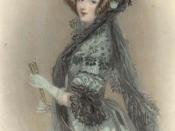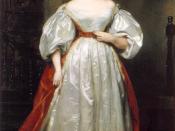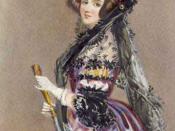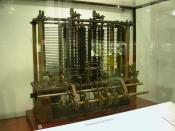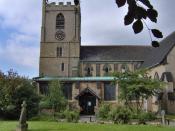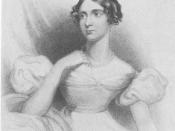Ada Lovelace was born December 10th 1815 and was the daughter of the poet Lord Byron and Anne Isabelle Milbanke who separated one month after Ada was born mainly due to Lord Byron's love affair with his half sister. Sadly it turns out Ada never met her father again as he left for Greece four months later. Eight years later Lord Byron died at the very young age of 36.
The lines from Byron's 'Childe Harold' were very well known at the time:- `Is thy face like thy mother's, my fair child! Ada! Sole daughter of my house and of my heart? When last I saw thy young blue eyes they smiled' And then we parted,-not as now we part, but with a hope.' Ada was an active girl. She loved gymnastics, dancing, and especially horseback riding. She became an accomplished musician, learning to play the piano, violin, and harp.
Her mother once commented that mechanical objects especially fascinated Ada; she loved trying to figure out what made machines work. Even though Ada was an active child she was very sickly. When she was fourteen, she suffered from a paralyzing illness that caused her to be unable to walk for three years.
Lady Byron did not really want her daughter to grow up to be a poet like her father. She thought being a poet was a waste of time and energy. So she insured that Ada would be tutored in Mathematics & Music which were close to her heart and would give her daughter the respect she deserved. But Ada's poetic side fortunately came out as her understanding of Mathematics was laced with imagination and creativity.
Lady Byron and Ada moved to London where they mixed with the elite. There, Ada was introduced to Mary Somerville who encouraged her in mathematical pursuits. It was at a dinner party hosted by Mrs. Somerville that Ada heard about Charles Babbage's ideas for a new calculating machine called the Analytical Engine. Finally in 1833 at the age of 17 she met Babbage and was fascinated with both him and his Analytical Engine. From then on they kept in correspondence on the topics of mathematics, logic, and ultimately all subjects. At the time women in the sciences was not permitted due to gender issues. She would not have even been permitted to attend college or university. To find people who would listen and take her seriously was a very hard thing to do. But this did little to discourage her enthusiasm, which her mother had encouraged in her youth, and meeting Charles Babbage started the ball rolling.
What drew Ada and Charles together was their passion for an idea and turn it into a reality. But it wasn't meant to be not for another hundred years until technology would catch up with their vision.
In 1835 at the age of 18 Ada married William King who was 10 years her senior. He was also a mathematician although not as skilled as his wife. They had three children together. William King then inherited a noble title in 1838 making them the Earl and Countess of Lovelace. The family and its fortune were very much controlled by Ada and due to her domineering nature her husband William rarely opposed her.
Approximately ten years later Ada produced a translation of Menabrea's 'Notions sur la machine analytique de Charles Babbage. In the annotations she describes Babbage's Engine saying 'The Analytical Engine weaves algebraic patterns, just as the Jacquard-loom weaves flowers and leaves' She also published a book on 'Mr. Babbage's Analytical Engine' in 1843 in which she explained how the machine would use Operation Cards to perform arithmetic on numerical data and to respond to symbols representing data. She explained in detail on the ability of the machine to be programmed. It is for this reason she is labeled the inventor of programming.
After these great developments and accomplishments her addiction for horse betting and her addiction to morphine (as a result of her treatment for illness) lead to her untimely downfall. This addiction to gambling led to massive debts and the sale of the family jewels. When she over came her illnesses she is quoted as saying ' I blame all my derangements on too much mathematics'. The mathematician De Morgan agreed with her that mathematics was too much of a strain for women, but never told Ada how much he admired her mathematical abilities. Throughout this bad time her husband William stood by her, but family fights led to many problems. Sadly in 1852 at the young age of 36 Ada died of Uterine Cancer. She was buried beside her father, Lord Byron, finally accepting her identity and her father she was taught to hate.
Ada's accomplishments in mathematics, sciences and of course programming have been recognised by her contemporaries. The American Military developed a computer language and named it in her honour. It is in use today mainly in Europe in the communication industry.
Even though she never went to college or university her enthusiasm, her love of mathematics and the sciences along with the people who cared for her led to this marvelous woman's great achievements. Other people on the other hand have very different views on her life and achievements. Some say she was a science fiction archetype, perhaps as "mad and bad" as her father. Others even say that she was not the first computer programmer, this honour they would give to Babbage's son. Whoever is right or wrong is not for me to say. At the very least, she was one of the most colourful and most loved characters in the history of computing.
References: (1) Lady Augusta Ada Byron Lovelace by Nancy Beach of the University of Minnesota http://cda.mrs.umn.edu/~beachnm/report.html (2) Ada Byron Lovelace The First Computer Programmer http://www.aimsedu.org/Math_History/Samples/ADA/Ada.html (3) The Babbage Pages. Augusta Ada Lovelace (nee Byron) http://www.ex.ac.uk/BABBAGE/ada.html (4) The Museum of Women. Ada Lovelace by Gill Thornhill http://www.amazoncity.com/technology/museum/lovelace.html
